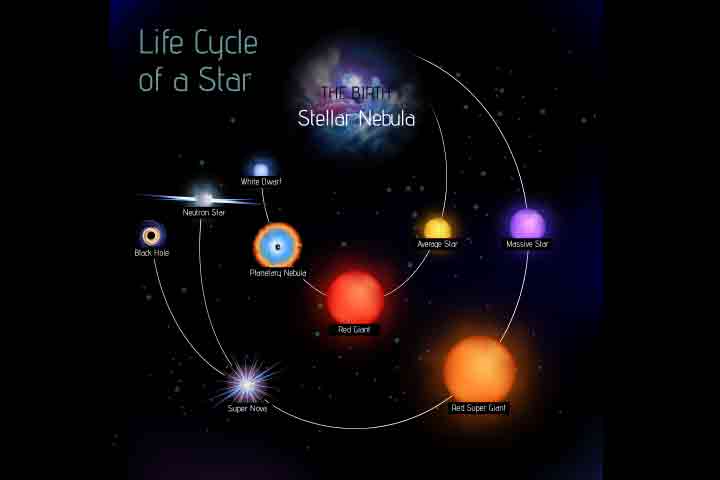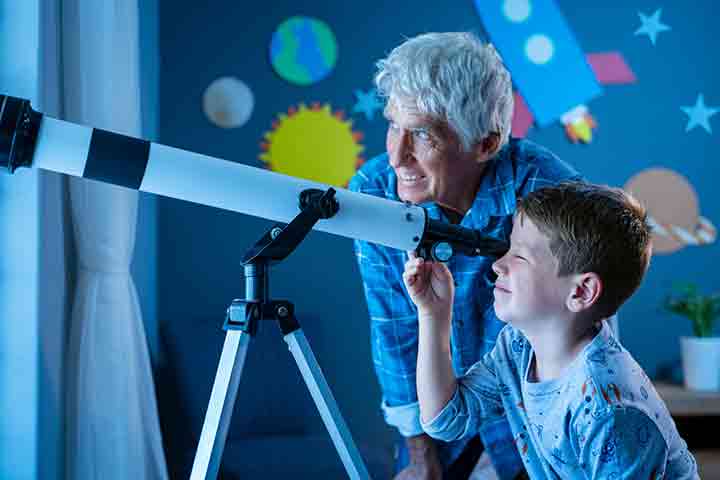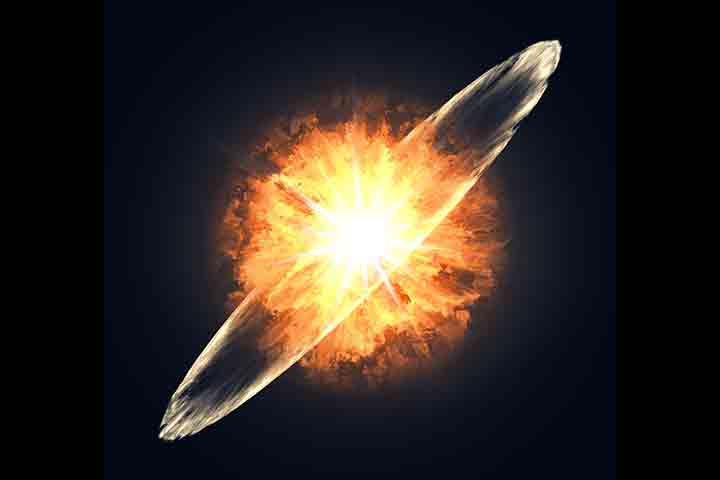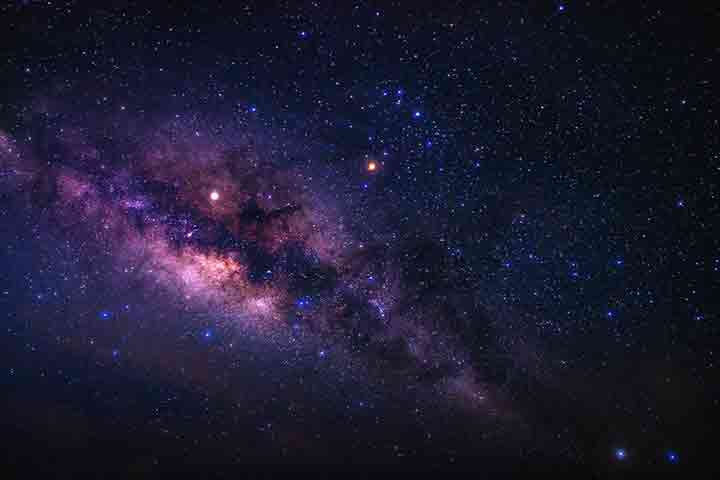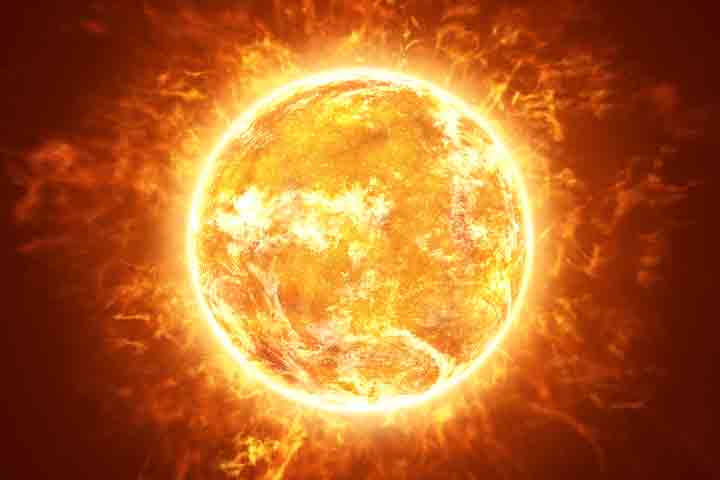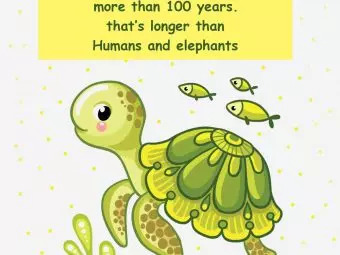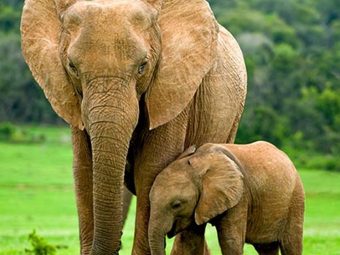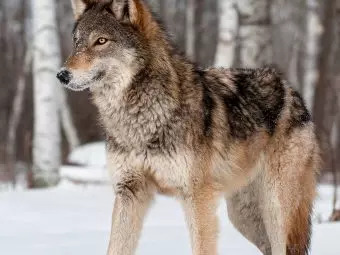
Image: Shutterstock
Stars fascinate children and even adults too. Stars have been studied for many millennia along with other heavenly bodies like the moon, asteroids, comets and meteors.So let’s check out some interesting stars facts for children from this post and keep them intrigued and encouraged to learn more about them. They can know some spellbinding stuff such as, ‘How far are the stars?’ ‘How do they twinkle?’ ‘How many of them are there?’ ‘How and ‘Why aren’t they visible at night?’ Keep reading to find the answers to these questions and more. You can even host trivia games during weekends, read the facts aloud, and feed their curiosity pangs.
What Is A Star Made Of?
Stars are huge exploding balls of gases, mainly hydrogen and helium. They are so hot that the gases undergo a constant nuclear reaction, like in a hydrogen bomb(1).
These constellations of stars shine by burning hydrogen into helium deep in their cores and then create heavy elements such as carbon, nitrogen, oxygen, and iron. When all the fuel is used up, which could take billions of years, the star ejects its materialsback into space, which then form a new star.Stars are of various sizes, and the closest star to our planet Earth is the Sun(2).
Stars are constantly present but can be seen only at night due to the brightness of the Sun. At night, when the sky gets dimmer, the stars can be seen(3).
Though most stars are made up of the elements mentioned above, an ancient star discovered in the constellation of Leo is said to be composed of extremely light elements. As you can see in the diagram below, the star is predominantly made of hydrogen and helium, while only a tiny part of it contains other heavy elements.
The composition of an ancient star
Source:The composition of a star that should not exist; ESO/Digitized Sky Survey 2Types Of Stars For Kids
When you look up into the night sky, you will find innumerable stars beyond your imagination, and what you see is only a tiny part of it.
Scientists have classified stars based on their spectra, which refers to the elements absorbed by them, and their temperature. Due to the variations in temperature, stars are of different colors and can be classified into the following (4).
1. O – type stars
These are the hottest stars and are blue. They are a million times brighter than the Sun.
2. B – type stars
These stars are blue-white and are hundreds to thousand times brighter than the Sun.
3. A-type stars
These are white and are about ten times brighter than the Sun.
4. F – type stars
These stars are yellow to white and are brighter than the Sun.
5. G – type stars
These are yellow stars and are bright. Our Sun is a G star.
6. K – type stars
These stars are orange to red and are cold.
7. M – type stars
These stars are red and are the coldest stars.
Life Cycle Of Stars For Kids
Image: IStock
The life cycle of a star starts from the giant clouds of dust and gases, known as nebulae. A nebula transforms into a protostar, which then becomes a main-sequence star.In this way, a star undergoes various transformations right from its birth and finally collapses to become a black hole(4)(5)(6)(7)(8).
Let’s have a look at the various stages of a star.
1. Nebula
This is the first stage in the life cycle of a star.A star is formed from the nebula, which is a massive cloud of dust and gas in space. It is mainly composed of hydrogen. The nebula collapses under its own gravitational pull to form a protostar.
2. Protostar
Theincreasing gravityand pressure make the protostar collapse. This results in the formation of a pre-main sequence star, which then turns into a main sequence star as the hydrogen fusion starts.
3. Main sequence star
As the pre-main sequence star begins to release energy and stops contracting, it starts to shine and forms a main sequence star. Our Sun is among one of the main sequence stars.These stars vary in size, mass, and temperature but carry the same process in their cores. They convert hydrogen into helium, creating a massive amount of energy.
The life span of main sequence stars depends on their size. As giant stars burn their fuel much faster, they may only last a few hundred thousand years, while smaller stars may last for several billion years because they burn their fuel much more slowly.
4. Red giant stars
When all the hydrogen is used up and the fusion stops, the main sequence stars enter the next stage. The hydrogen shell of the core ignites, causing the stars to expand about 100 times bigger than the main sequence star. The star then turns into a red giant.
5. White dwarf stars and supernova
When all the helium is used up in the core, and no other element is left to be used as a fuel, the red giant stars transform to white dwarf stars.The smaller stars collapse due to their own gravity as there is no more fusion reaction. Still, the stars may shine due to the immense heat before they cool down and turn into black dwarfs. They are different from dwarf planets which are small planetary mass objects in the sun’s direct orbit.
Larger stars with more mass continue with the nuclear reaction and keep expanding until they explode, a phenomenon called a supernova. When a supernova occurs, it throws a huge amount of hot gases into space.
6. Blackhole or neutron stars
A massive supernova or explosion can leave behind a black hole or a neutron star.
28 Facts About Stars For Kids
Image: IStock
Here are some interesting facts about stars that will pique your child’s interest (5), (6), (7), (8), (9), (10), (11), (12), (13), (14), (15), (16), (17), (18), (19), (20), (21), (22), (23), (24), (25), (26), (27), (28), (29)
- The majority of the stars in the universe are red dwarfs. Red dwarfs have a lifespan of tens of billions of years.
- 星星闪烁由于空气Ea的运动rth’s atmosphere.
- The light emitted by the stars takes years to reach us. So, when you look at a star, you actually see how the star looked in the past.
- Proxima Centauri, also known as Alpha Centauri, is the nearest star to our Earth. It is 40,208,000,000,000km away from us and 1.5 times brighter than our Sun.
- Smaller stars live longer than bigger stars.
- The oldest record of a supernova dates back to 185 A.D. Chinese astronomers were known to have witnessed the event.
Image: IStock
- Stars are mostly present in groups.
- The Sun accounts for 99.86% of the mass in oursolar system.
- Approximately 25 to 50 supernovae are discovered each year in other galaxies via telescopes. The Hubble Telescope is a space telescope that provides stunning images of celestial objects.
- Each year, the Milky Way Galaxy creates about seven new stars.
- There are about 100-400 billion stars in the Milky Way Galaxy.
- The asterism Pleiades, also known as the Seven Sisters, is found in the constellation Taurus, one of the prominent zodiac signs.
- The nearest large galaxy to our Milky Way Galaxy is the Andromeda Galaxy. Scientists predict that these two galaxies will collide in approximately four billion years.
Image: IStock
- Sirius is the brightest star in the night sky.
- The Sun will never turn into a black hole, as it is not big enough.
- The distance between the Sun and Earth is about 93 million miles (150km). This distance is also known as the Astronomical Unit, which is used for measuring distances within the Solar System or around other stars.
- Only stars with more than twenty times the mass of the Sun will become black holes.
- Approximately 75% of the mass of the star is ejected into space in a supernova.
- A blackhole emits X-rays and Gamma-rays.
- The Sun can hold about 1.3 million Earths.
Image: IStock
- Deneb is one of the most distant stars that we can see with our naked eye.
- The light of the Sun takes 8.3 minutes to reachthe Earth.
- Betelgeuse is known to be the closest supergiant star to Earth.
- Our Sun is 4.5 billion years old.
- Our Sun is expected to be in its main sequence phase for another five billion years.
- Stars are a combination of gasses; they do not have a solid mass.
- The gravity of black holes is so strong that it can even trap light.
- The most massive stars, known as hypergiants, may be 100 or more times larger thanthe Sun.
Apart from the beautiful display of starry nights on a clear sky, our earth hosts many natural light displays or phenomena such as the Aurora Borealis or the Solar Eclipse.
Frequently Asked Questions
1. How many planets can a star have?
Some stars may have about seven planets. Whereas others may not have any planets at all (30). However, whether or not a star has planets cannot be known because a star may have planets that are not yet identified.
2. What is the difference between a star and a planet?
A star possesses and emits its own light. Whereas planets rotate and revolve on their own axis and reflect light from an external source. Stars have a high temperature while planets have a relatively low temperature. Stars may have matter like hydrogen, helium, and other light elements whereas planets contain solids, liquids, and gasses.
3. Can the stars move?
Yes, the stars constantly move. However, since they are very far away from earth, it is not possible to see them with the naked eye (31).
4. How do stars affect the universe?
Each star has its own solar system and at least one planet orbiting them; thus, it provides stability to the universe. The Sun is also a star that makes life possible on Earth and determines seasons, weather, day and night, and other changes. In addition, stars have been a part of traditions, customs, religions, and other aspects of life (35).
5. How many stars are in the universe?
The counting of stars is comparable to counting sand grains, which means it’s impossible to count them. NASA states that the Milky Way alone is estimated to have about 100 billion stars; however, this is just a rough number and there can be billions of more stars (36).
6. What is the hottest star in the universe?
The Wolf-Rayet star WR 102, at 210,000 Kelvin temperature, is one of the hottest stars in the universe.
These fun facts about stars for kids will pique your little one’s interest in the vast universe. You can answer all their questions about the stars and discuss them in detail while stargazing. When you share and converse about these exciting facts, encourage them to read up on more interesting facts about the stars and the universe. It will allow them to explore their interest in astronomy at an early age. Also, it will expand their knowledge and inspire them to study more.
Infographic: Fascinating Facts About Stars For Children
Looking up at the night sky, the millions of stars twinkling can surely intrigue your children to know more about them. So, check out the infographic below for some amazing facts about stars you can share with your children next time you stargaze with them.

Illustration: Momjunction Design Team
Get high-quality PDF version by clicking below.
Download Infographic
Key Pointers
- Stars are a combination of gases and have no solid mass.
- Based on their mass and spectra, stars can be of various sizes and colors.
- From how they twinkle to how they become a black hole, share these interesting facts about stars with kids as you scroll further.
Are you curious about the stars in the sky? Watch this video discover the secrets of the stars with this fun and educational video.
References:
- What are stars made of?
https://www.qrg.northwestern.edu/projects/vss/docs/space-environment/2-what-are-stars-made-of.html - What are stars made of?
https://coolcosmos.ipac.caltech.edu/ask/205-What-are-stars-made-of- - Why do stars only come out at night?
https://coolcosmos.ipac.caltech.edu/ask/212-Why-do-stars-only-come-out-at-night- - What is an Exoplanet?
https://exoplanets.nasa.gov/what-is-an-exoplanet/stars/ - Life Cycle of a Star.
https://www.schoolsobservatory.org/learn/astro/stars/cycle - The Life of a Star.
https://www.astro.keele.ac.uk/workx/starlife/StarpageS_26M.html - Exploring the stars.
https://warwick.ac.uk/newsandevents/knowledgecentre/science/physics-astrophysics/star_types/ - Stars.
https://science.nasa.gov/astrophysics/focus-areas/how-do-stars-form-and-evolve - The Nearest Neighbor Star.
https://imagine.gsfc.nasa.gov/features/cosmic/nearest_star_info.html - Meet the Workaholic Star
Betelgeuse. - Stars.
https://imagine.gsfc.nasa.gov/science/objects/stars1.html - Red Dwarf.
https://astronomy.swin.edu.au/cosmos/r/red+dwarf - Why do the stars twinkle?
https://coolcosmos.ipac.caltech.edu/ask/210-Why-do-the-stars-twinkle- - How old is the sunlight you see?
https://wonderdome.co.uk/sunlight-photons-age/ - Stars.
https://science.nasa.gov/astrophysics/focus-areas/how-do-stars-form-and-evolve - How Many Stars Are There In The Universe?
https://skyandtelescope.org/astronomy-resources/how-many-stars-are-there/ - Orion, the Hunter.
https://stardate.org/astro-guide/orion-hunter-0 - The Dispersion of Elements.
https://imagine.gsfc.nasa.gov/educators/lessons/xray_spectra/background-elements.html - What Color is the Sun?
https://eclipse2017.nasa.gov/what-color-sun - Stars and Universe.
https://ww2.odu.edu/~tmmathew/geol110/stars.shtml - How Many Stars in the Milky Way?
https://asd.gsfc.nasa.gov/blueshift/index.php/2015/07/22/how-many-stars-in-the-milky-way/ - The Milky Way Galaxy.
https://imagine.gsfc.nasa.gov/science/objects/milkyway1.html - What Is a Black Hole?
https://www.nasa.gov/audience/forstudents/k-4/stories/nasa-knows/what-is-a-black-hole-k4.html - Our Sun
https://solarsystem.nasa.gov/solar-system/sun/in-depth/ - How Old Is the Sun?
https://spaceplace.nasa.gov/sun-age/en/ - Stars.
https://imagine.gsfc.nasa.gov/science/objects/stars1.html - Oldest Recorded Supernova.
https://www.nasa.gov/multimedia/imagegallery/image_feature_2173.html - Astronomy Picture of the Day – Index – Stars: Individual.
https://apod.nasa.gov/apod/individual_stars.html - Milky Way Churns Out Seven New Stars Per Year
Scientists Say. - How Many Habitable Zone Planets Can Orbit a Host Star?
https://astrobiology.nasa.gov/news/how-many-habitable-zone-planets-can-orbit-a-host-star/#:~:text=Their%20model%20determined%20that%20itsix%20planets%20with%20liquid%20water - Why are all the stars fixed in space?
https://www.wtamu.edu/~cbaird/sq/2013/10/16/why-are-all-the-stars-fixed-in-space/#:~:text=The%20stars%20are%20not%20fixedthat%20seems%20to%20never%20change - The Helix Nebula • NGC 7293.
https://www.nasa.gov/sites/default/files/atoms/files/03-nebulae-the-helix-nebula-ngc-7293.pdf - Does every black hole contain a singularity?
https://www.wtamu.edu/~cbaird/sq/2013/09/13/does-every-black-hole-contain-a-singularity/#:~:text=A%20singularity%20is%20a%20point - How old are galaxies?
https://spaceplace.nasa.gov/galaxies-age/en/#:~:text=Astronomers%20believe%20that%20our%20own - The Importance of Stars for Humans.
https://ec.europa.eu/programmes/erasmus-plus/project-result-content/2b975140-fa95-457f-b53b-b65395c64743/THE%20IMPORTANCE%20OF%20STARS%20FOR%20HUMANS.pdf - Beyond Our Solar System.
https://solarsystem.nasa.gov/solar-system/beyond/overview/



